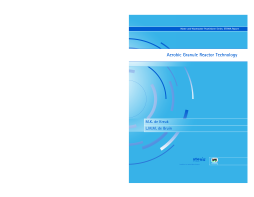
Additional Information
Book Details
Abstract
A new development for the treatment of domestic wastewater is a technology based on aerobic granular sludge. Granular sludge can be developed under specific process conditions. Because of the unique properties of this granular sludge, high volumetric loading rates of aeration tanks can be applied. Thanks to excellent settling properties, the separation of treated wastewater and granular sludge can take place at high hydraulic loading rates. Depending on the chosen process configuration good effluent quality can be obtained, complying with the stringent effluent requirements regarding nitrogen and phosphorus, which can be expected in the future. In this way aerobic granular sludge has the potential to contribute significantly to wastewater treatment management. This report describes the results of research carried out at the Technical University of Delft.
Table of Contents
| Section Title | Page | Action | Price |
|---|---|---|---|
| TABLE OF CONTENTS | 1 | ||
| PREFACE | vii | ||
| SUMMARY | viii | ||
| 1.0 INTRODUCTION | xi | ||
| History of the project | xi | ||
| Objectives | xii | ||
| 2.0 METHODS | xiii | ||
| Reactor set-up | xiii | ||
| Operational procedures | xiii | ||
| Control | xiv | ||
| Analytical procedures | xiv | ||
| 3.0 INFLUENCE OF FEEDING TIME | xvi | ||
| 3.1 Introduction | xvi | ||
| 3.2 Bottleneck of scale-up | xvii | ||
| 3.3 Results | xvii | ||
| 3.3.1 Granulation | xvii | ||
| 3.3.2 Conversion Processes | xviii | ||
| 3.4 Conclusions | xx | ||
| 4.0 INFLUENCE OF THE DISSOLVED OXYGEN CONCENTRATION | xxi | ||
| 4.1 Introduction | xxi | ||
| 4.2 Low DO and pulse feed | xxi | ||
| 4.2.1 Granulation | xxi | ||
| 4.2.2 Conversion processes | xxiii | ||
| 4.3 Low DO and long anaerobic feeding | xxiii | ||
| 4.3.1 Granulation | xxiii | ||
| 4.3.2 Conversion processes | xxiv | ||
| 4.4 Conclusions | xxv | ||
| 5.0 INFLUENCE OF THE REACTOR CONFIGURATION | xxvii | ||
| 5.1 Introduction | xxvii | ||
| 5.2 Results | xxvii | ||
| 5.2.1 Granulation | xxvii | ||
| 5.2.2 Conversion processes | xxviii | ||
| 5.3 Conclusion | xxviii | ||
| 6.0 EXPERIMENT WITH PRE-TREATED SEWAGE | xxix | ||
| 6.1 Introduction | xxix | ||
| 6.2 Selection of the influent | xxix | ||
| 6.2.1 Pre-treatment | xxix | ||
| 6.2.2 Selection of the raw sewage | xxix | ||
| 6.3 Results | xxx | ||
| 6.3.1 Granulation | xxx | ||
| 6.3.2 Conversion processes | xxxii | ||
| 6.4 Conclusions | xxxiii | ||
| 7.0 DESIGN AND ECONOMICS OF A FULL-SCALE GSBR TREATMENT PLANT | xxxiv | ||
| 7.1 Introduction | xxxiv | ||
| 7.2 General basic conditions | xxxiv | ||
| 7.2.1 Capacity and wastewater composition | xxxiv | ||
| 7.2.2 Effluent requirements | xxxv | ||
| 7.2.3 Flow pattern | xxxv | ||
| 7.2.4 Cost estimates | xxxvi | ||
| 7.2.5 Footprint and land price | xxxvi | ||
| 7.3 Reference systems | xxxvi | ||
| 7.3.1 Introduction | xxxvi | ||
| 7.3.2 Design assumptions | xxxvii | ||
| 7.3.3 Dimensions and costs | xxxvii | ||
| 7.4 Interaction between feasibility study and research | xxxix | ||
| 7.5 Design GSBR | xl | ||
| 7.5.1 Assumptions | xl | ||
| 7.5.2 Buffer capacity | xlii | ||
| 7.5.3 Design outline | xlii | ||
| 7.5.4 Effluent quality | xlii | ||
| 7.5.5 Costs | xliii | ||
| 7.6 Sensitivity analysis | xliv | ||
| 7.6.1 RWF/DWF ratio | xliv | ||
| 7.6.2 Land price | xlv | ||
| 7.6.3 Post treatment alternatives | xlv | ||
| 7.6.4 Round or rectangular? | xlv | ||
| 7.6.5 Cycle time | xlvi | ||
| 7.7 Conclusions and potential | xlvi | ||
| 7.7.1 Reference alternatives | xlvi | ||
| 7.7.2 GSBR | xlvi | ||
| 8.0 CONCLUSIONS AND RECOMMENDATIONS | xlviii | ||
| 9.0 SYMBOLS AND ABBREVIATIONS | l | ||
| 10.0 LITERATURE | li | ||
| APPENDIX 1 | liii | ||
| PFDS REFERENCE SYSTEMS | liv | ||
| APPENDIX 2 | lv | ||
| PFDS GSBR ALTERNATIVES | lvi | ||
| APPENDIX 3 | lvi | ||
| DESIGN AND COSTS OF REFERENCE 1 | lviii | ||
| APPENDIX 4 | lvii | ||
| DESIGN AND COSTS OF REFERENCE 2 | lviii | ||
| APPENDIX 5 | lviii | ||
| DESIGN AND COSTS OF REFERENCE 3 | lix | ||
| APPENDIX 6 | lix | ||
| DESIGN AND COSTS GSBR WITH POST TREATMENT AND BIO-P | lx | ||
| APPENDIX 7 | lx |
